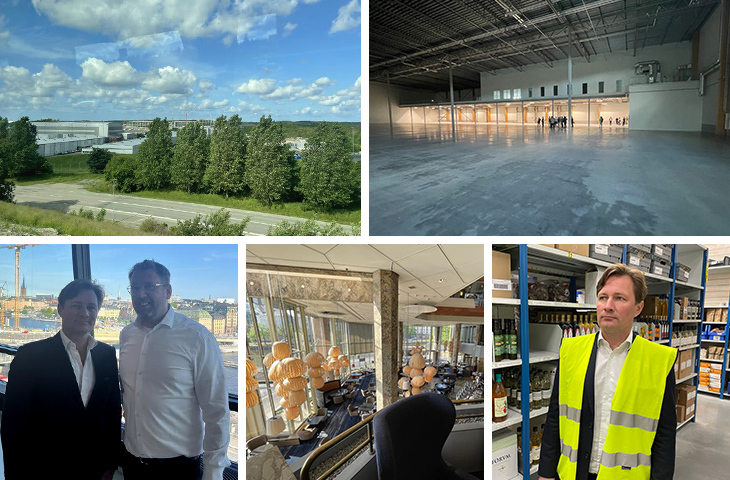On-the-ground: Exploring economic and real estate trends in Iceland, Lithuania, Finland, and Sweden

Iceland: A welcoming haven of opportunity
Walking through the streets of Reykjavik, it's easy to feel the relaxed pace of life in Iceland. Unlike the hustle and bustle of Stockholm, people here seem to stroll rather than rush, taking their time to enjoy the crisp, clean air. This calm extends to the economic landscape as well. Iceland's economic outlook is notably bright, often seen as a blend of the best elements from both Europe and the USA.
Tourism remains the lifeblood of the economy, with the country aiming to become a key stopover destination for transatlantic flights. Plans for significant investment in the international airport over the next five years reflect this ambition.
2023 saw a remarkable 3% increase in population, primarily due to labour immigration. This influx speaks to Iceland's robust job market, where unemployment is virtually non-existent. Housing prices have stabilized, bringing relief to many. The banking sector is strong, with institutions like Íslandsbanki focusing more on infrastructure projects. Arion Bank is expanding its reach to the Faroe Islands and Greenland, while Landsbankinn is on the verge of acquiring Kvika’s insurance business, pending regulatory approval.
Despite high mortgage interest rates, homeowners manage by paying only the real interest, adding the inflation portion to their loan principal. This innovative approach helps maintain financial stability for families.
Vilnius, Lithuania: A city of high standards and cautious lending
Stepping into Vilnius, one is immediately struck by the modern, high-standard office buildings that surpass even those in Finland. There's a palpable sense of cautious optimism here. Baltic companies are better capitalized than their Swedish counterparts, but households carry fewer loans and possess fewer assets.
Swedbank's caution in lending reflects higher perceived macroeconomic risks in the Baltics. This conservative approach has led to strict amortisation requirements for both businesses and households, resulting in stagnant lending growth. The business community here often looks to expand first within the Baltic states, then to Poland, which contrasts with expectations that they might favour Finnish markets.
Finland: Real estate challenges in a post-pandemic world
In Finland, a particularly in Helsinki, the real estate market is in a state of flux. Visiting various properties, one can't help but notice the lack of maintenance in older buildings, particularly hotels. The oversupply of hotel rooms, a hangover from the pandemic and geopolitical tensions, is evident. The absence of Russian tourists due to the Ukraine conflict has left a significant gap.
Many hotels underwent superficial renovations around 2015-2016, giving them a dated feel reminiscent of mid-90s Swedish hotels. Some real estate investment funds in Finland are currently closed, with investors eager to withdraw capital but finding no buyers, leading to a standstill in transactions.
Residential rents are set by market prices, leading to potential volatility. This, combined with the country's uncertain economic conditions, poses risks that might not be fully reflected in current valuations. New construction has slowed significantly, indicating a cautious approach by developers.
Gothenburg and Stockholm: Contrasting growth stories in Sweden
Gothenburg: A city on the rise
In Gothenburg, the energy is palpable. Over the past decade, the city has outpaced Stockholm and the rest of Sweden in growth, boasting double the export levels of the capital. However, land allocation remains a challenge, potentially driving up rents. The region is buzzing with developments driven by electrification initiatives and influence of Volvo.
The demand for commercial properties is high, and Gothenburg stands as Sweden's hottest market for logistics. The cost of constructing logistics facilities is substantial due to strict insulation requirements, adding significant expenses to projects.
Stockholm: Sluggish development amidst cautious optimism
In Stockholm, the pace is more subdued. New construction projects are slow to start, with developers focusing on completing existing ones. JM, a major player in the market, continues to buy land from the municipality despite the option to return it, fearing future difficulties in obtaining land permits. To maintain liquidity, JM is discounting apartments nearing completion, which is evident in their financial statements.
Building costs have likely peaked, with stable cement prices and declining timber prices. However, the financial struggles of suppliers mean that cement prices are unlikely to drop. Atrium Ljungberg remains committed to strategic investments in areas like Slakthusområdet and Slussen, with promising returns expected from these prime locations.
The logistics property market in the Mälaren Valley (particularly around Enköping) faces challenges, with speculative overbuilding leading to an oversupply. Rosersberg and Jönköping are also showing signs of speculative oversupply.
Conclusion
Experiencing these diverse regions firsthand reveals a tapestry of opportunities and challenges. Iceland's serene yet dynamic economic landscape, Lithuania's cautious yet sophisticated business environment, Finland's real estate hurdles, and the contrasting growth stories of Gothenburg and Stockholm in Sweden all paint a vivid picture of current market dynamics. Each region, with its unique characteristics and economic conditions, offers valuable insights into the broader European economic and real estate trends.





